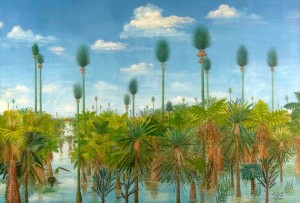
An artist's impression of a 300-million-year-old peat forest in northern China, based on plant fossils preserved in a huge volcanic ash-fall. PNAS
Paleobiologists of all kinds are used to dealing with frustrating scraps. Occasionally they get entire bones and once in a blue moon a nearly complete skeleton or fossil of an extinct plant or animal. But scientists working with remains below a Mongolian coal mine have done one better, they found a 300 million year old forest preserved in volcanic ash and have brought it to virtual life in what is being called the Permian Pompeii:
(Nature) — “This is a wonderful study,” says Robert Gastaldo, a palaeobotanist at Colby College in Waterville, Maine. “Many of these plant groups we knew from other places, but we had no idea that they actually grew together.” … When the forest was alive, it sat on the northwestern edge of a large tropical island off the eastern shore of the supercontinent Pangaea, the researchers say. Most forests like this one had died out elsewhere millions of years earlier — their habitats had dried as landmasses comprising the supercontinent came together and the forests ended up farther from the coasts, says Ralph Taggart, a palaeoecologist at Michigan State University in East Lansing. In that sense, he notes, even before it was buried, this peat forest was already frozen in time as forests elsewhere evolved.
The Permian Period lasted from 300 MYA to about 250 MYA. It was a fascinating time, before the first dinosaurs, when large mammal like reptiles ruled the super continent Pangea and a vast global ocean. It was the first modern ecology complete with vertyebrates in now familiar niches, along with insects, forests, swamps, beaches, and lakes bustling with fish and amphibians. But it wasn’t to last. The Permian ended 250 MYA with the greatest mass extinction in the fossil record. By some estimates over 90% of all living species passed away, forever, in a geologically brief period of time. Most left few relatives and fewer remains for us to puzzle over. Which is what’s so cool about this find, it could help us shed some light on many of those tantalizing mysteries!

Wow, amazing! What a world that would be to visit… we always see movies about the dinosaurs. I think it would be nice to see a blockbuster documentary on the Cambrian Explosion all the way up to the Permian Extinction. Such diversity!
Fascinating. Thanks for posting.